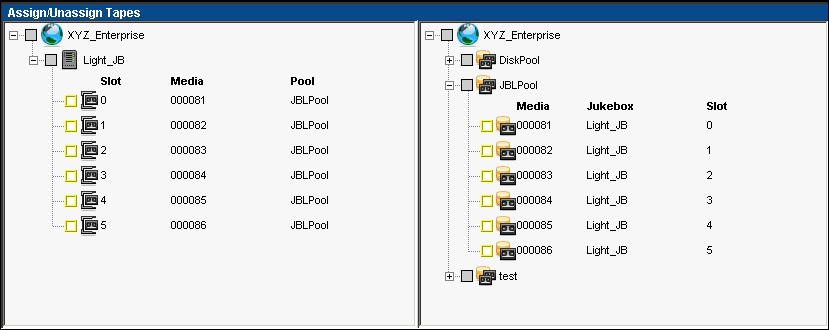Assigning and Unassigning Media to/from Tape Library Slots
DPX automatically tracks the relationship of tapes to tape library tape slots. For example, when a tape is added to a tape library through an import/export port, DPX is aware of the new tape and the slot it occupies; that is, the Catalog assigns the tape to a slot.
However, the Catalog can become unsynchronized if, for example, a tape is physically removed from a tape library. In such cases, you can use the assign/unassign function of DPX to update the Catalog.
To assign media to tape library slots:
On the Configure Device window, click Display Slots and Media Controls.
The Assign/Unassign Tapes window appears. Tape libraries are displayed in the left pane and media pools are displayed in the right pane.
In the left pane, expand the desired tape library to the tape slot level. In the right pane, expand the desired media pools to the tape level. The following shows one tape library with six defined slots (all of which have tapes assigned) and three media pools, with the JBLPool expanded.

In the right pane, select the unassigned tapes you want to assign.
Do one of the following:
In the left pane, select the “empty” slots to which you want to assign the tapes. For multiple selections, use CTRL-click and SHIFT-click.
Then click Assign Tapes to Slots.
Drag and drop the tapes to one “empty” slot. If you selected multiple tapes, the slot should be the first slot that you want to assign tapes to.
DPX assigns the tapes to the slots in volume number and slot number order.
To unassign media from tape library slots:
On the Configure Device window, click Display Slots and Media Controls.
The Assign/Unassign Tapes window appears. Tape libraries are displayed in the left pane and media pools are displayed in the right pane.
In the left pane, expand the desired tape library to the tape slot level.
In the left pane, select the “filled” slots that you want to unassign. For multiple selections, use CTRL-click and SHIFT-click.
Do one of the following:
Click Unassign Tapes from Slots.
Drag and drop the selected tapes to any media pool.
DPX unassigns the slots. Each tape remains in the media pool to which it had been added.
Considerations for Assigning and Unassigning Media and Slots
The following should be considered when assigning media to slots or unassigning media from slots:
Irregular tape libraries, such as ACSLS, IBM ATL, or AML, do not appear on the Assign/Unassign Tapes window.
A tape cannot be assigned to a slot that already has a tape assigned to it.
An already assigned tape cannot be reassigned unless it is unassigned first.
When you assign media using drag-and-drop, tapes cannot be assigned to slots that have not been rendered to the Assign/Unassign Tapes window. (DPX renders slots and tapes to the management console in batches of 200; scrolling renders the next batch). Selected tapes that do not get assigned remain selected for user convenience.
When assigning media by using the Assign Tapes to Slots button:
If more slots than tapes are selected, only the necessary number of slots receive tape assignments.
If more tapes than slots are selected, the selected tapes that do not get assigned remain selected for user convenience.